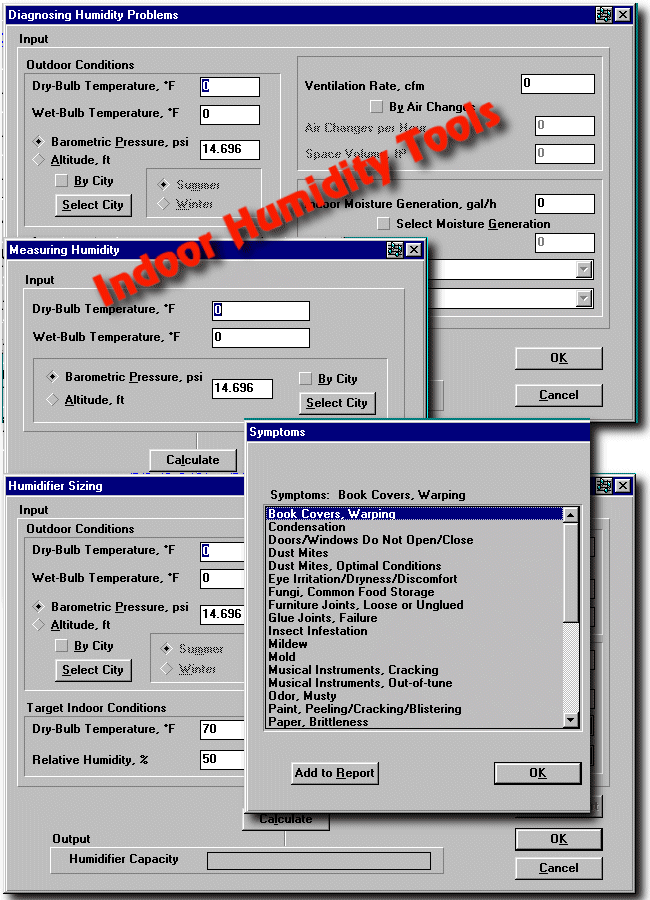Overview
Many problems are caused by high or low indoor humidity, such as mold growth, skin problems, static electricity, condensation, wood rot or warpage, paper deterioration, damage to audiovisual materials, and a variety of other ill health effects and material damage. Indoor Humidity Tools provides the diagnoses necessary to understand indoor humidity problems, and the solutions required to overcome them.
Indoor Humidity Tools is intended to be a practical program for everyday use by engineers, industrial hygienists and safety professionals, architects, building scientists, contractors, government air quality specialists, and other professionals in the indoor air quality field. Indoor Humidity Tools works on Windows 3.x, 95, 98, NT, 2000, and XP.
Feature Descriptions
Here are some more in-depth descriptions of the features.
- DIAGNOSES HUMIDITY PROBLEMS - Without humidification or dehumidification, an indoor space will frequently become too humid or too dry. Indoor Humidity Tools assists in diagnosing such conditions and in identifying solutions, such as controlling moisture sources or ventilation rates.
- DIAGNOSES CONDENSATION - Select the type of surface you are concerned about, such as a specific kind of window, and Indoor Humidity Tools will calculate the surface temperature and whether condensation will occur on that surface. You can then test condensation solutions given different humidity levels, or different surface types.
- ESTIMATES HUMIDITY GENERATION RATES - In order to solve indoor humidity or dryness problems, it is frequently necessary to know the rate at which humidity is being generated. Indoor Humidity Tools provides default values for a variety of humidity sources, such as people and pools of water. For those situations in which the source of the humidity is not known, the ESTIMATING HUMIDITY GENERATION module can be used to calculate generation rates from measured indoor conditions.
- SIZES HUMIDIFIERS - Indoor Humidity Tools can be used to calculate the size of a humidifier to meet desired indoor humidity conditions. Often, humidifiers are needed in winter, when the outdoors is dry. They are also needed to meet critical indoor humidity conditions for a variety of applications.
- SIZES DEHUMIDIFIERS - Dehumidifiers are often needed in the summer, when humidity conditions are high. Like humidifiers, they are often also needed for particular applications where humidity control is important, or where indoor moisture generation rates are high.
- MEASURES HUMIDITY By measuring temperatures, it is possible to measure humidity. The temperatures to be measured are the dry bulb temperature and the wet bulb temperature. These are typically measured with a sling psychrometer. Once the measurements have been taken, use Indoor Humidity Tools to calculate humidity.
- PROVIDES EXTENSIVE REFERENCE INFORMATION: Indoor Humidity Tools displays the following reference information in quick and easy lookup windows, and for insertion into reports. Codes and Standards - Indoor Humidity Tools lists several widely used codes and standards, and indicates the indoor humidity required by each. Humidity Level Recommendations A variety of indoor building types, room types, products and processes are listed. Choose the building or room type and product or process, and a recommended humidity level or range is provided. If an associated temperature is also recommended, this is provided too. Physical Symptoms - Indoor Humidity Tools lists a variety of health and material symptoms that are related to indoor humidity levels, and provides the humidity conditions which cause these symptoms. Local Climatic Data To help you calculate indoor humidity levels, Indoor Humidity Tools lists the seasonal extreme dry and wet bulb temperatures and altitude for your area.
Demonstration Limits
The demo version of Indoor Humidity Tools is a fully functioning program, with the following exception: Outdoor temperature is limited to the range 32-41 F. This prevents diagnosing indoor humidity problems over a full range of conditions, because indoor humidity depends strongly on outdoor humidity, especially in mid-summer and mid-winter outdoor temperature extremes.



